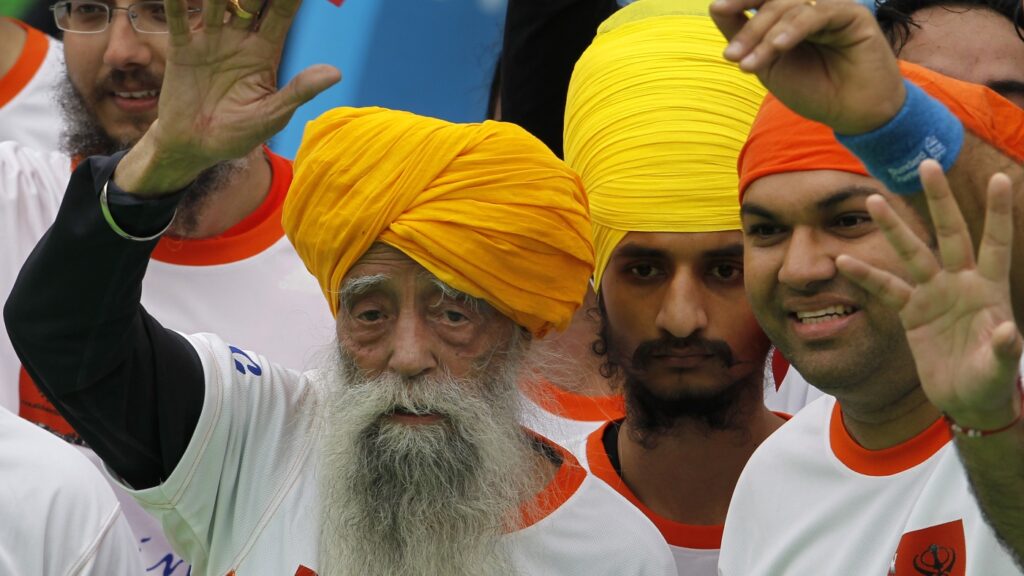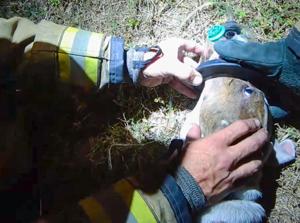
Centenarian marathon runner Fauja Singh, 101, left, originally from Beas Pind, in Jalandhar, India but who now lives in London, waves after finishing a 10-kilometer race, held as part of the annual Hong Kong Marathon, in Hong Kong Sunday, Feb. 24, 2013. Singh will retire from public racing after competing in the marathon. (AP Photo/Vincent Yu)
Fauja Singh, the celebrated marathon runner from India, died tragically on July 14, 2025, after being struck by a speeding SUV while checking on his rice fields in Punjab. He was 114 years old. Singh, known for his remarkable story and resilience, captured the hearts of many during his running career, but his life came to an untimely end due to a hit-and-run incident that underscores the dangers of India’s roads.
Singh’s journey into marathon running began in London in 1999 when he was coached by Harmandar Singh. At that time, Fauja was 89 years old and had recently moved to the UK to live with his son in the borough of Ilford. His initial appearance in a three-piece suit highlighted his unique personality. Harmandar recalled, “I sort of had to tell him that if he was running down the road wearing a three-piece suit, there is a possibility that the police will say, what are you running from?”
The motivation behind Fauja’s running was deeply personal. He had endured the loss of his daughter, wife, and younger son, prompting concerns from his family about his mental health. Harmandar, having experienced a similar loss, understood the importance of keeping Fauja engaged and active.
Over the next 14 years, Fauja Singh became a formidable athlete, completing nine full marathons and numerous shorter races. His tenacity was evident as he trained diligently, often not fully grasping the distance he was running. “I used that to my advantage,” Harmandar noted, explaining how he would inform Fauja that remaining distances were in kilometers rather than miles.
Fauja made headlines worldwide for his achievements, including his personal best of five hours and forty minutes at the 2003 Toronto Waterfront Marathon. In 2011, he became the oldest person to finish a marathon, completing the same event at age 100. Despite his accomplishments, he was unable to secure an official record due to the absence of a birth certificate, a common issue for many from colonial India.
His fame led to various media engagements, including a feature in Adidas’s “Impossible is nothing” campaign, and biographical works celebrating his life. Family members proudly displayed his medals and trophies in their home in Punjab, creating a legacy that inspired many.
Fauja retired from competitive running in 2013, returning to India around 2022. Locals continued to honor him, inviting him to sporting events, where he often insisted on receiving medals for his participation. His granddaughter, Japneet Kaur, recalled his playful nature, saying, “He’d go as a guest but tell the organizers, I also want a medal.”
The circumstances of his death brought renewed attention to road safety in India. After being struck by an SUV driven by Amrit Singh Dhillon, Fauja lay on the busy highway for several minutes before assistance arrived. Balbir Singh, a friend of Fauja’s family, expressed regret, stating, “The doctors said he could’ve been saved if we’d reached sooner.” The hit-and-run incident drew swift police action, resulting in the arrest of Dhillon, who attempted to evade capture.
Authorities, including India’s highway minister Nitin Gadkari, have acknowledged the alarming rate of traffic fatalities in the country, with over 150,000 deaths reported annually. Gadkari remarked in Parliament that the death toll continues to rise, which reflects ongoing challenges in road safety management.
The dangers of India’s roads are compounded by poor traffic engineering and a lack of pedestrian infrastructure. Local traffic police chief Manjit Singh attributed some reckless behavior to the influence of foreign media on youth, while also highlighting the tendency of pedestrians to take shortcuts across busy roads.
Rohit Baluja, director of the Indian Institute of Road Traffic Education, emphasized that many accidents stem from infrastructural failures rather than solely driver negligence. He pointed out that the area where Fauja was killed lacked adequate warning signs and pedestrian facilities, which contributed to the tragedy.
Despite the circumstances leading to his death, Fauja Singh lived a remarkable life. He remained active and healthy until his final days, consuming a balanced diet and engaging in physical activity without the aid of medication. His granddaughter fondly recalled moments of learning from him, as he shared his running tips in their last interactions.
As tributes pour in from around the world, Fauja Singh’s legacy as an extraordinary athlete and a symbol of resilience will continue to inspire future generations. His story serves as a poignant reminder of both the human spirit’s endurance and the pressing need for improved safety measures on the roads of India.







